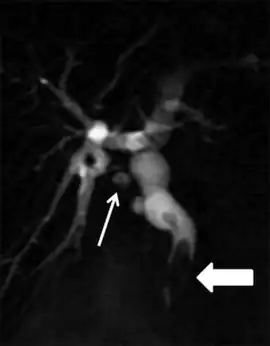Postcholecystectomy syndrome
| Postcholecystectomy syndrome | |
|---|---|
Postcholecystectomy syndrome (PCS) describes the presence of abdominal symptoms after a cholecystectomy (gallbladder removal).
Symptoms occur in about 5 to 40 percent of patients who undergo cholecystectomy,[1] and can be transient, persistent or lifelong.[2][3] The chronic condition is diagnosed in approximately 10% of postcholecystectomy cases.
The pain associated with postcholecystectomy syndrome is usually ascribed to either sphincter of Oddi dysfunction or to post-surgical adhesions.[4] A recent 2008 study shows that postcholecystectomy syndrome can be caused by biliary microlithiasis.[5] Approximately 50% of cases are due to biliary causes such as remaining stone, biliary injury, dysmotility and choledococyst. The remaining 50% are due to non-biliary causes. This is because upper abdominal pain and gallstones are both common but are not always related.
Non-biliary causes of PCS may be caused by a functional gastrointestinal disorder, such as functional dyspepsia.[6]
Chronic diarrhea in postcholecystectomy syndrome is a type of bile acid diarrhea (type 3).[3] This can be treated with a bile acid sequestrant like cholestyramine,[3] colestipol[2] or colesevelam,[7] which may be better tolerated.[8]
Signs and symptoms
Symptoms of postcholecystectomy syndrome may include:[9]
Diagnostics

- Ultrasound of the abdominal cavity.
- General and biochemical blood.
- Intravenous cholangiography.
- Esophagogastroduodenoscopy for examination of the stomach, duodenum and the area major duodenal papilla.
- Retrograde cholangiopancreatography.
- Analysis of biliary sludge obtained through endoscopic retrograde cholangiopancreatography (ERCP)
- SeHCAT or other test for bile acid diarrhea
Treatment
Some individuals may benefit from diet modification, such as a reduced fat diet, following cholecystectomy. The liver produces bile and the gallbladder acts as reservoir. From the gallbladder, bile enters the intestine in individual portions. In the absence of a gallbladder, bile enters the intestine constantly, but in small quantities. Thus, it may be insufficient for the digestion of fatty foods. Postcholecystectomy syndrome treatment depends on the identified violations that led to it. Typically, the patient is recommended a dietary restriction table with fatty foods, enzyme preparations, antispasmodics, and sometimes cholagogue.
If the pain is caused by biliary microlithiasis, oral ursodeoxycholic acid can alleviate the condition.[5]
A trial of bile acid sequestrant therapy is recommended for bile acid diarrhea.[2][8]
Functional dyspepsia is subdivided into Epigastric Distress Syndrome (EPS) and Post-Prandial Distress Syndrome (PDS).[11] Treatment for EPS and PDS can both include proton pump inhibitors and dopamine antagonists. Tricyclic antidepressants have also been proven effective for nausea, vomiting, early satiety, impaired motility and other related symptoms.[12]
When investigation reveals no abnormalities within the abdominal cavity, the attending physician may consider Anterior cutaneous nerve entrapment syndrome (ACNES) as a possible cause. ACNES may present with pseudovisceral symptoms, including nausea, bloating, diarrhea and early satiety.[13]
References
- ↑ "Postcholecystectomy syndrome". WebMD. Archived from the original on 2007-07-02. Retrieved 2009-03-07.
- 1 2 3 Danley T, St Anna L (October 2011). "Postcholecystectomy diarrhea: What relieves it?". The Journal of Family Practice. 60 (10): 632c–d. PMID 21977493. Archived from the original on 2019-12-13. Retrieved 2021-09-27.
- 1 2 3 Sciarretta G, Furno A, Mazzoni M, Malaguti P (December 1992). "Post-cholecystectomy diarrhea: evidence of bile acid malabsorption assessed by SeHCAT test". The American Journal of Gastroenterology. 87 (12): 1852–4. PMID 1449156.
- ↑ Hyvärinen H, Sipponen P, Silvennoinen E (December 1990). "Intestinal adhesions: an overlooked cause of the postcholecystectomy syndrome". Hepatogastroenterology. 37 (Suppl 2): 58–61. PMID 2083937.
- 1 2 Okoro N, Patel A, Goldstein M, Narahari N, Cai Q (July 2008). "Ursodeoxycholic acid treatment for patients with postcholecystectomy pain and bile microlithiasis". Gastrointestinal Endoscopy. 68 (1): 69–74. doi:10.1016/j.gie.2007.09.046. PMID 18577477.
- ↑ Schmidt M, Søndenaa K, Dumot JA, Rosenblatt S, Hausken T, Ramnefjell M, Njølstad G, Eide GE (28 March 2012). "Post-cholecystectomy symptoms were caused by persistence of a functional gastrointestinal disorder". World Journal of Gastroenterology. 18 (12): 1365–72. doi:10.3748/wjg.v18.i12.1365. PMC 3319963. PMID 22493550.
- ↑ Odunsi-Shiyanbade ST, Camilleri M, McKinzie S, et al. (February 2010). "Effects of chenodeoxycholate and a bile acid sequestrant, colesevelam, on intestinal transit and bowel function". Clinical Gastroenterology and Hepatology. 8 (2): 159–65. doi:10.1016/j.cgh.2009.10.020. PMC 2822105. PMID 19879973.
- 1 2 Mottacki N, Simrén M, Bajor A (2016). "Review article: bile acid diarrhoea - pathogenesis, diagnosis and management". Aliment. Pharmacol. Ther. 43 (8): 884–898. doi:10.1111/apt.13570. PMID 26913381.
- ↑ nhs.uk, Complications of a gallbladder removal Archived 2017-09-20 at the Wayback Machine
- ↑ Lamberts MP, Lugtenberg M, Rovers MM, Roukema AJ, Drenth JP, Westert GP, van Laarhoven CJ (2013). "Persistent and de novo symptoms after cholecystectomy: a systematic review of cholecystectomy effectiveness". Surg Endosc. 27 (3): 709–18. doi:10.1007/s00464-012-2516-9. PMID 23052498. S2CID 206999263.
- ↑ Shin CM (July 2013). "Overlap between postprandial distress and epigastric pain syndromes in functional dyspepsia: its implications for research and clinical practice (am j gastroenterol 2013;108:767-774)". Journal of Neurogastroenterology and Motility. 19 (3): 409–11. doi:10.5056/jnm.2013.19.3.409. PMC 3714422. PMID 23875111.
- ↑ Talley NJ, Herrick L, Locke GR (February 2010). "Antidepressants in functional dyspepsia". Expert Review of Gastroenterology & Hepatology. 4 (1): 5–8. doi:10.1586/egh.09.73. PMC 4070655. PMID 20136584.
- ↑ Suleiman, Saud; Johnston, David E. (August 2001). "The Abdominal Wall: An Overlooked Source of Pain". American Family Physician. 64 (3): 431–438. PMID 11515832. Archived from the original on 2021-08-02. Retrieved 2021-09-27.
External links
| Classification |
|---|